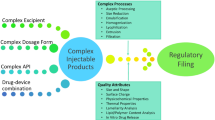Abstract
The efficiency of water-in-oil (W/O) and gelatin-microsphere-in-oil (W/O-G) emulsions as drug delivery systems for achieving specificity into lymphatics was evaluated in the rat stomach. Following injection into the stomach wall, radioactivities of131I-labeled o-iodohippuric acid (IH, watersoluble model compound) and [14C]tripalmitin (TP, tracer of oil) in blood, regional lymph nodes, thoracic lymph, and stomach were determined. Since increased transfer of TP indicated the facilitation of lymphatic transport of IH following injection of W/O and W/O-G emulsions, the existence of a special transport mechanism through which drug and oil are delivered together was confirmed for this injection site. W/O and W/O-G emulsions increased the concentration-time curve (AUC) of IH in the regional lymph nodes (1.7 and 5.5 times that of aqueous solution injection, respectively), so the improvement of bioavailability was accomplished. In addition, a prolonged release of IH and decrease of its maximum blood concentration were obtained following injection of W/O-G emulsion. These results suggest that W/O and W/O-G emulsions satisfy many of the criteria of an ideal drug delivery system for cancer chemotherapy. An abundant supply of lymphatic vessels in the stomach wall exhibited the efficiency of these delivery systems more clearly than did thigh muscle.
Similar content being viewed by others
References
Y. Nakamoto, M. Fujiwara, T. Noguchi, T., Kimura, S. Muranishi, and H. Sezaki. Studies on pharmaceutical modification of anticancer agents. I. Enhancement of lymphatic transport of mitomycin C by parenteral emulsions.Chem. Pharm. Bull. 23:2232–2238 (1975).
Y. Nakamoto, M. Hashida, S. Muranishi, and H. Sezaki. Studies on pharmaceutical modification of anticancer agents. II. Enhanced delivery of bleomycin into lymph by emulsions and drying emulsions.Chem. Pharm. Bull. 23:3125–3131 (1975).
M. Hashida, M. Egawa, S. Muranishi, and H. Sezaki. Role of intramuscular administration of water-in-oil emulsions as a method for increasing the delivery of anticancer agents to regional lymphatics.J. Pharmacokin. Biopharm. 5:225–239 (1977).
T. Takahashi, M. Mizuno, Y. Fujita, S. Ueda, B. Nishioka, and S. Majima. Increased concentration of anticancer agents in regional lymph nodes by fat emulsions, with special reference to chemotherapy of metastasis.Gann 64:345–350 (1973).
N. L. Tilney. Patterns of lymphatic drainage in the adult laboratory rat.J. Anat. 109:369–383 (1971).
J. L. Bollman, J. C. Cain, and J. H. Grindlay. Techniques for the collection of lymph from the liver, small intestine, or thoracic duct of the rat.J. Lab. Clin. Med. 33:1349–1352 (1948)
D. T. Mahin and R. T. Loftberg. A simplified method of sample preparation for determination of tritium, carbon-14, or sulfur-35 in blood or tissue by liquid scintillation counting.Anal. Biochem. 16:500–509 (1966).
R. E. Johnson. A conceptual approach to integrated cancer therapy.Cancer 35:1–4 (1975).
V. A. Cooperative Surgical Adjuvant Study Group. Use of thio-tepa as an adjuvant of carcinoma of the stomach.Cancer 18:291–297 (1965).
W. H. Cole, R. G. Mrazek, S. G. Economou, G. O. McDonald, D. P. Slaughter, and F. W. Sterhl. Adjuvant chemotherapy.Cancer 18:1529–1535 (1965).
J. M. Yoffey and F. C. Courtice.Lymphatics, Lymph, and the Lymphomyeloid Complex, Academic Press, London, 1971, Chap. 4.
M. S. Sheppard and E. E. Sterns. The difference in the clearance of intestinal albumin by the lymphatics from the stomach and the small and large intestine.Surg. Gynecol. Obstet. 140:405–408 (1975).
J. J. P. de Lima, P. Alantara, and D. S. Garcia. An indirect method for the estimation of lymph Mow.Lymphology' 6:169–174 (1973).
C. Bach and G. P. Lewis. Lymph flow and lymph protein concentration in the skin and muscle of the rabbit hind limb.J. Physiol. 235:477–492 (1973).
T. Nishimura, H. Kobayashi, K. Okumura, S. Muranishi, and H. Sezaki. Intramuscular absorption of drugs from the oily solutions in the rat.Chem. Pharm. Bull. 22:1275–1284 (1974).
B. E. Ballard. Biopharmaceutical considerations in subcutaneous and intramuscular drug administration.J. Pharm. Sci. 57:357–378 (1968).
Author information
Authors and Affiliations
Rights and permissions
About this article
Cite this article
Hashida, M., Takahashi, Y., Muranishi, S. et al. An application of water-in-oil and gelatin-microsphere-in-oil emulsions to specific delivery of anticancer agent into stomach lymphatics. Journal of Pharmacokinetics and Biopharmaceutics 5, 241–255 (1977). https://doi.org/10.1007/BF01065398
Received:
Revised:
Published:
Issue Date:
DOI: https://doi.org/10.1007/BF01065398




